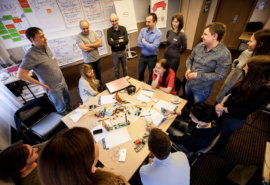Tend Your Garden First

Sometimes the best answer is not improving the existing service or product, but chucking it for something new.
User Story Mapping
I’m a big fan of User Story Mapping, the process created by Jeff Patton that helps teams understand their customers’ personas, goals, and steps in their journey. Elements are written on stickies and stuck on a wall. Most importantly, the story-mapping process helps development teams and executives understand the breadth of the work that needs to be done and which small chunks can be built quickly to meet business goals.

It may seem simple, but the process has been revolutionary for many software developers, particularly those in the Agile community.
1 to n
The problem with user story mapping – or at least with the way I’ve seen it used in many companies – is that often encourages only incremental improvements to an existing product or service (in Peter Thiel’s book Zero to One, this is a “1 to n” approach).
Sometimes the best answer is not to improve the current service or product, but to eliminate the existing solution in favor of something completely new.

As an example, you certainly could pull apart a toaster to figure out how the contraption might be improved.
Or you could step back and try to better understand what the user wanted in the first place. Warm bread? Two pieces of bread with crust on all 4 sides? Browner bread?
Maybe we just enjoy the toast-making experience.
Something New
Why bother to recreate our beloved toaster? The one we have works.
The same could be said about buying music. Only a few years ago (well, 2005), the owners of Tower Records thought what we really wanted was a listening station with a ‘scan and listen’ reader and better headphones.
Turns out, we didn’t really want to go to the record store at all – at least, not when given the choice of going to the store or downloading music on the go.
These days, many of us don’t even do that (I just say, “Alexa, play The Foals”).
I’m not sure I need pre-toasted bread, but if a warm slice materialized out of thin air like my music does, I’d eat it.
Concept Gardening
The step that needs to happen before mapping the user journey – at least, when we want to create revolutionary change – is a step called “Concept Gardening.” It’s a process used by Frog Design, but has been around under many different names for years (most famously, “Blue Sky”, used by Disney’s Imagineering).
A concept garden is a collection of visualizations of different ideas that can be reviewed, mixed, matched, and ultimately prototyped and tested.
When concept gardening, the team takes time to step away from existing technology, tools, and processes and imagines customers in multiple environments enjoying the product or service in ways that may seem just a bit impossible.
Here are a few tips for creating your own concept garden:
- Set Goals: In clear language, set out the business goals, whether that be revenue, repeat visits, or awareness. Write them up on a large white board. Keep them simple.
- Set Constraints: Set out the known constraints: timelines and budgets. Again, keep them simple.
- Identify Users: Identify your key users. Restrict them to a small number of user/archetypes/personas you are focusing on. No more than 4 or 5, tops.
- Understand Their Why: List their wants, and keep asking why they want it. What would make them the happiest?
- Brainstorm: Brainstorm unique solutions occurring in unique environments. What tools might work where? It’s OK to add some science fiction here.
- Sketch. Sketch your ideas, even if you can’t sketch. Use stick figures if you have to (but it’s a good idea to have an artist revise all the concepts so they all have a similar look and feel).
- Mix and Match: Take some time to mix and match aspects of the different concepts.
Get everyone involved in cultivating the concepts, not just product managers (though the whole team needs to pay close attention to their understanding of the market and the user). If possible, bring in experts from outside your field or company to join in.
Your concept garden may ultimately look something like this (each includes a one-line description of the concept, the key persona, and a simple sketch):

Here’s what your concept garden might look like after you mix, match, select the top candidates and have an artist do rough sketches of the concepts:

Prototype. Test. Prototype. Test. Repeat.
Of course, at some point, you’ll need to focus more on the science and less on the fiction. But before you start running cost models, I strongly recommend prototyping the 4 or 5 concept models that resonate the most with your customers. Using paper, papier-mâché, or HTML, do whatever you can to make the concept real to your audience.
Then get it out for testing – and learn!
Conclusion:
User Story Mapping is a simple, elegant, and useful technique for arranging epics and stories for software development. But mapping too early in the process can prevent teams from creating valuable innovation.
Try stepping back and cultivating your own garden of concepts first.
Related Posts
-
After determining a company’s quarterly business goals, th...Jul 23, 2016 / 0 comments
-
I smooshed a squirrel while moving the BBQ grill yesterday. ...Dec 12, 2018 / 0 comments
-
Have you ever wondered how much of the information in all bo...Jun 13, 2012 / 0 comments
Categories
Recent Posts
CONTACT INFO
Welcome to Coral Mountain Consulting, a Deliverse company. We are glad you found us. If you need to contact us, please call or email Barc directly.
Phone: 1-(626) 644-3857
Office: 2122 New York Drive, Altadena, CA 91001







